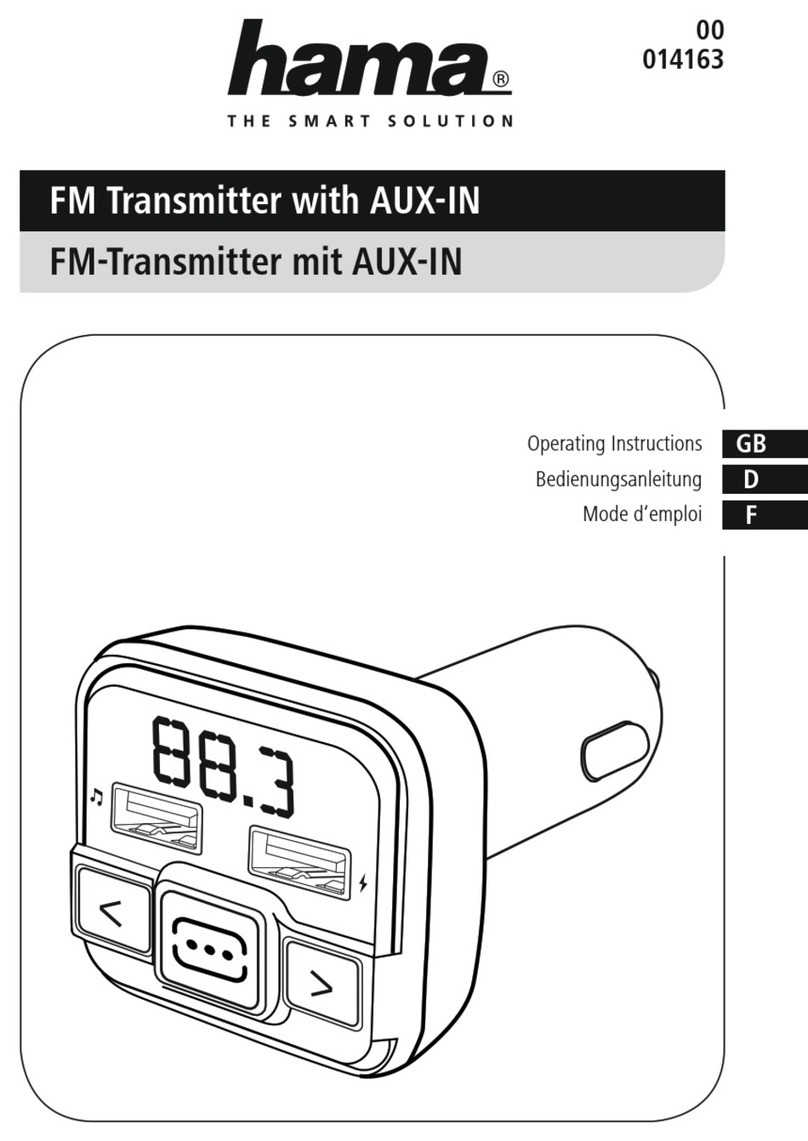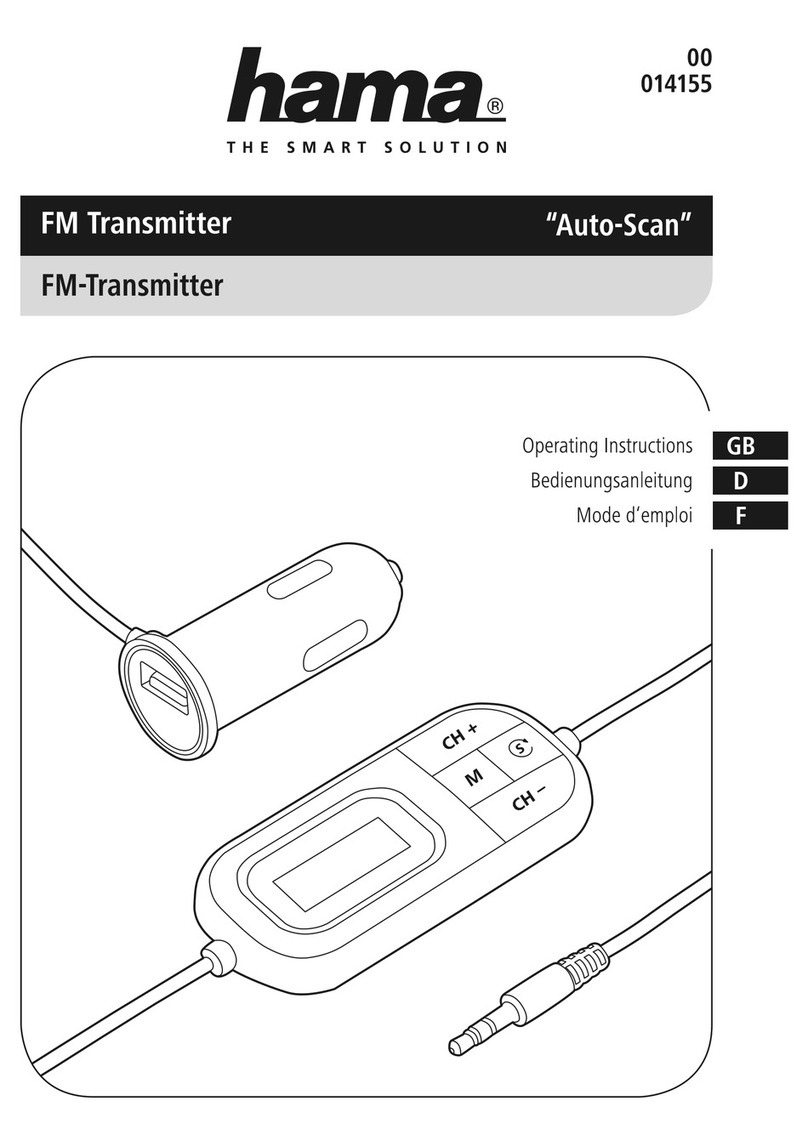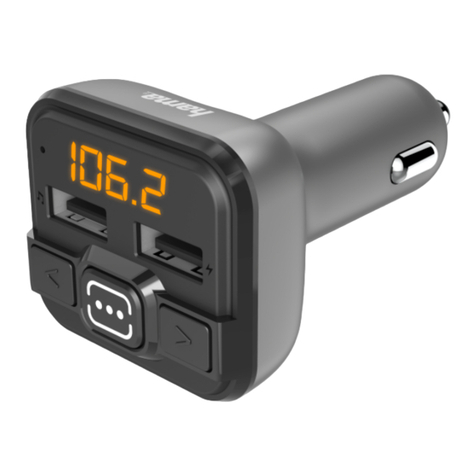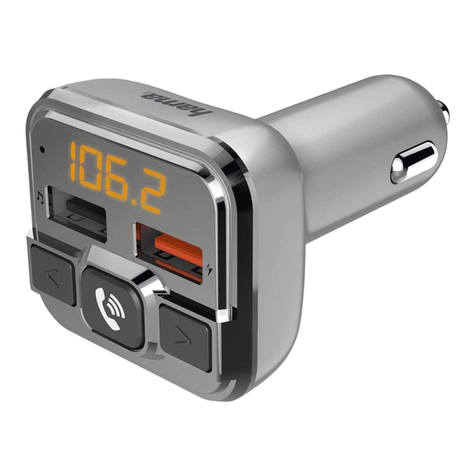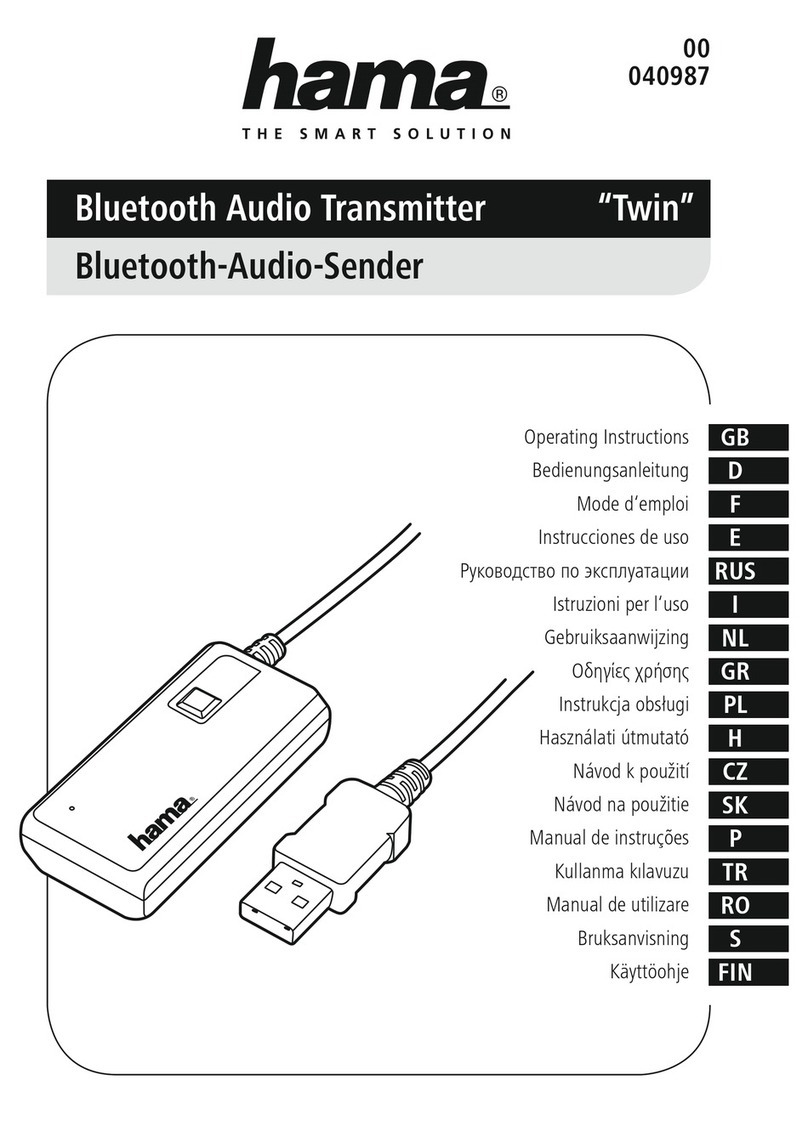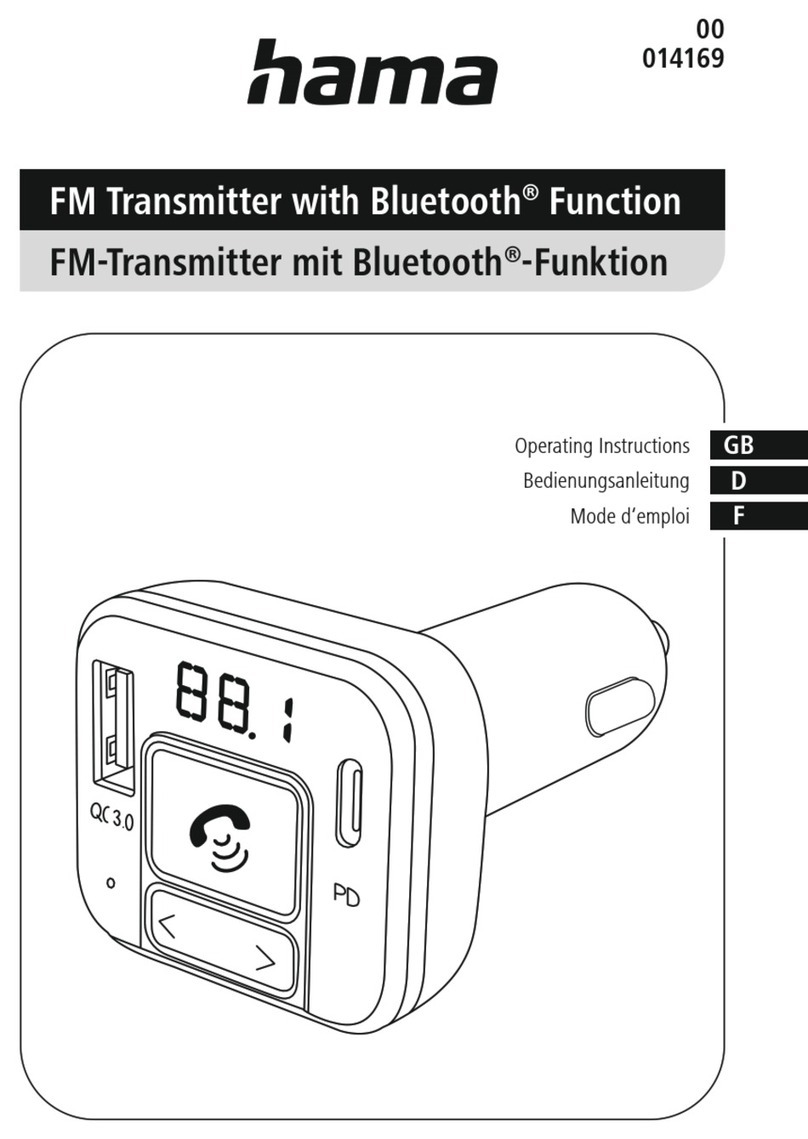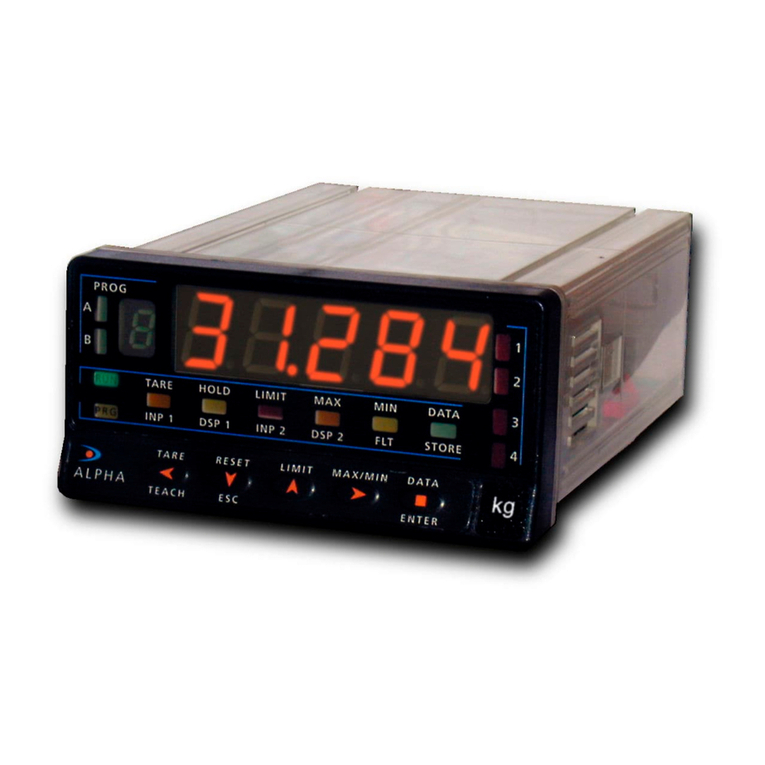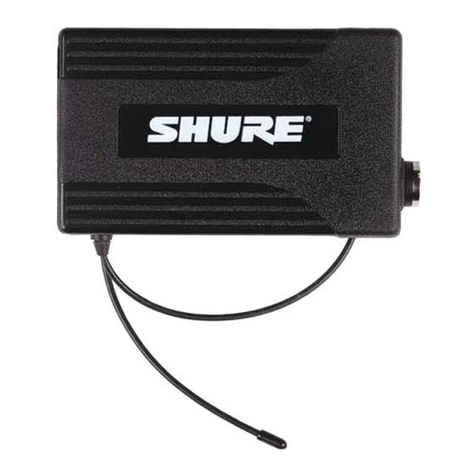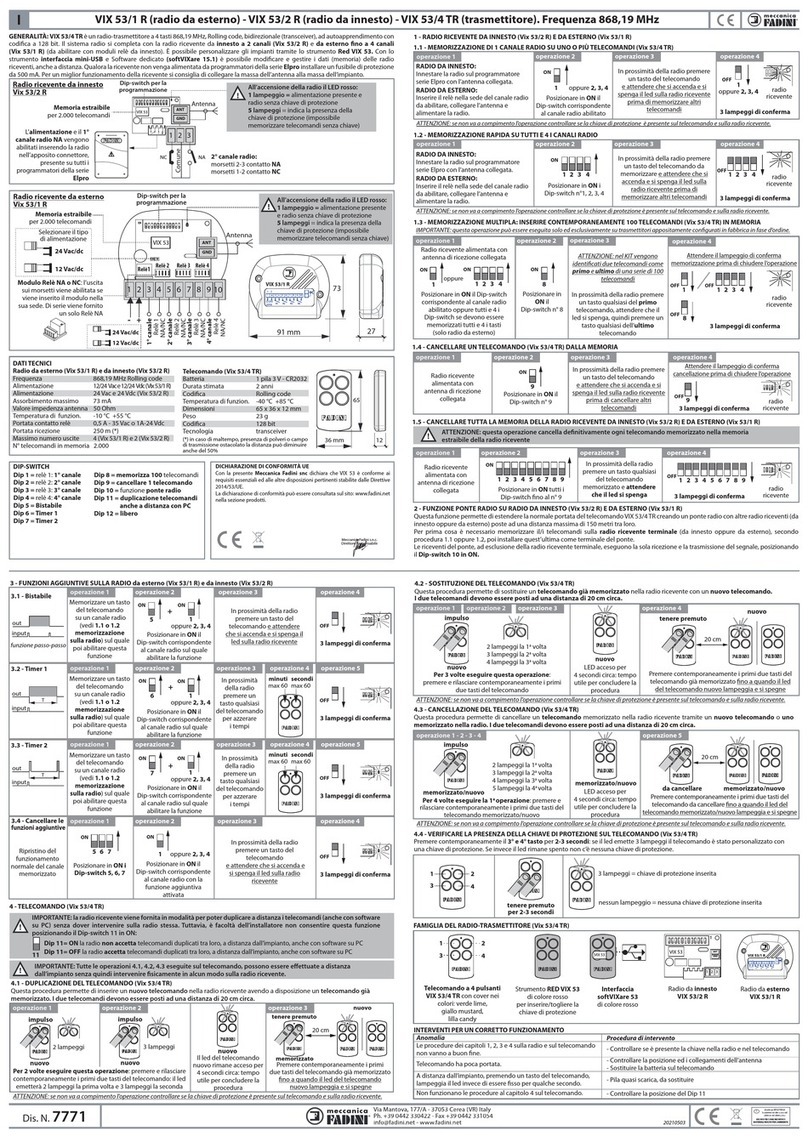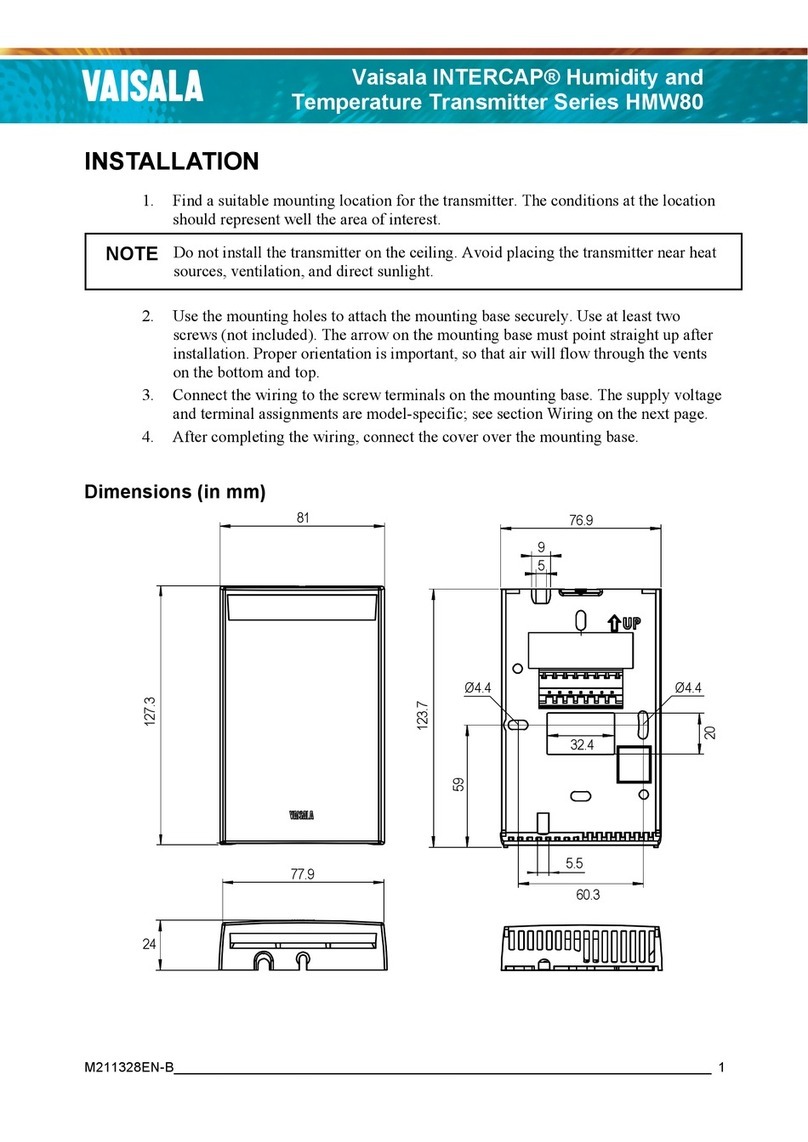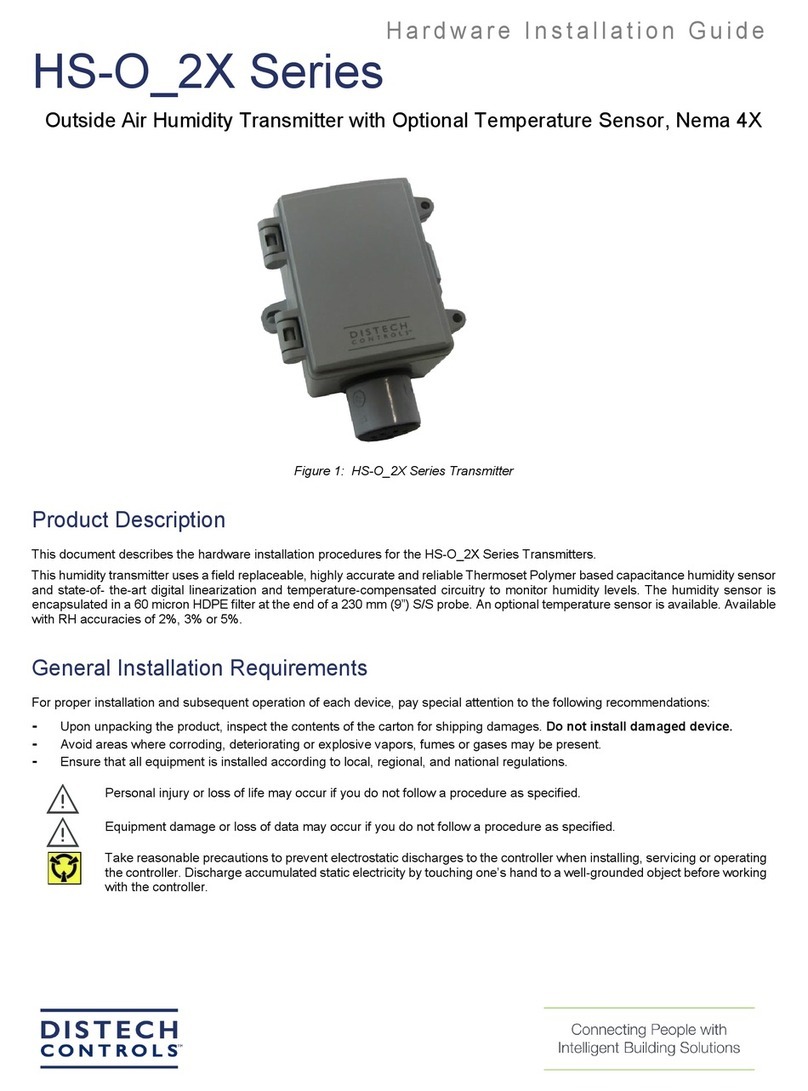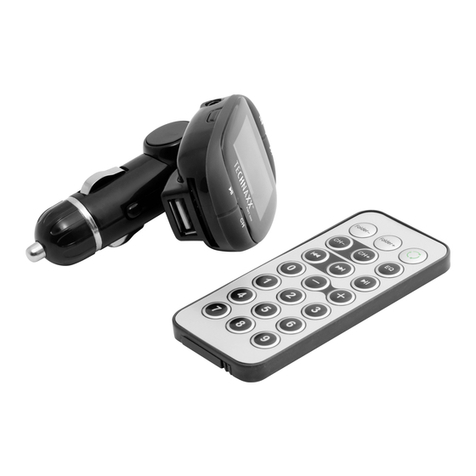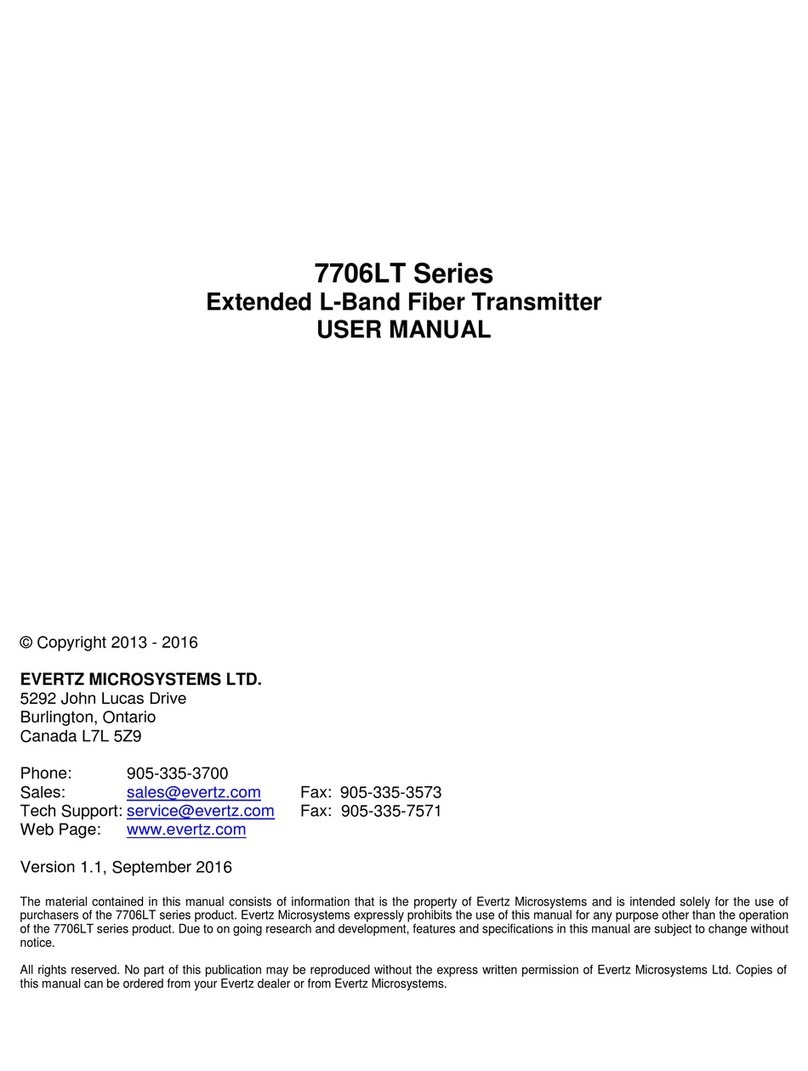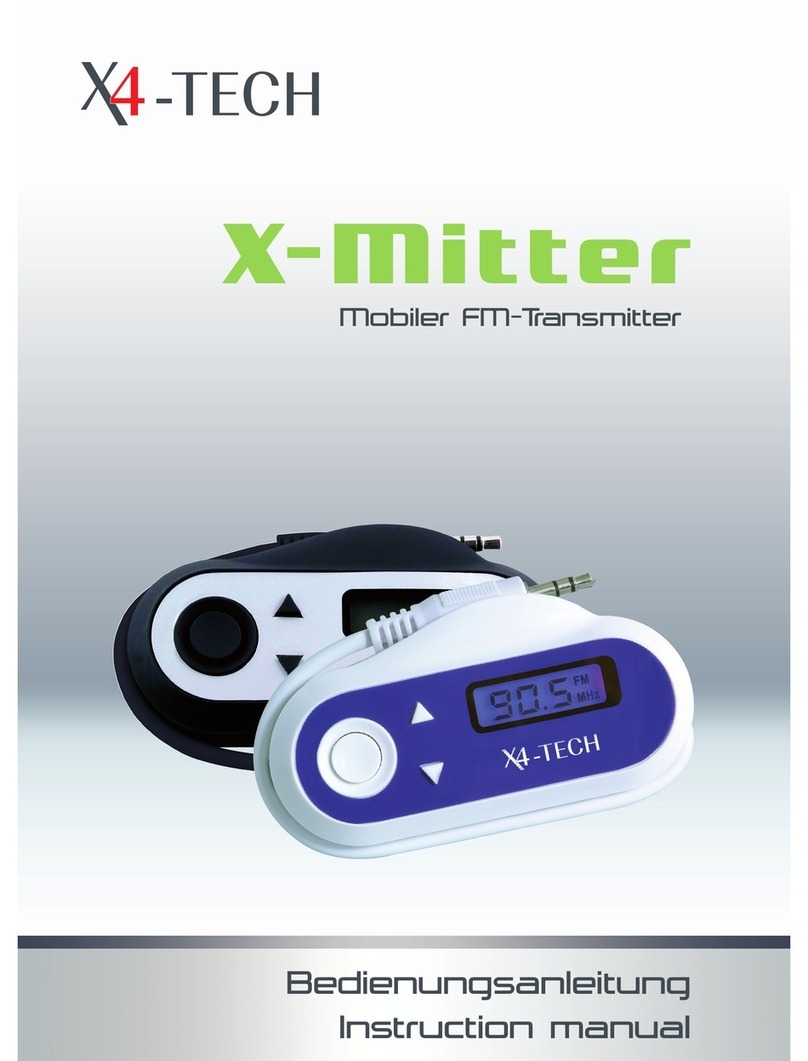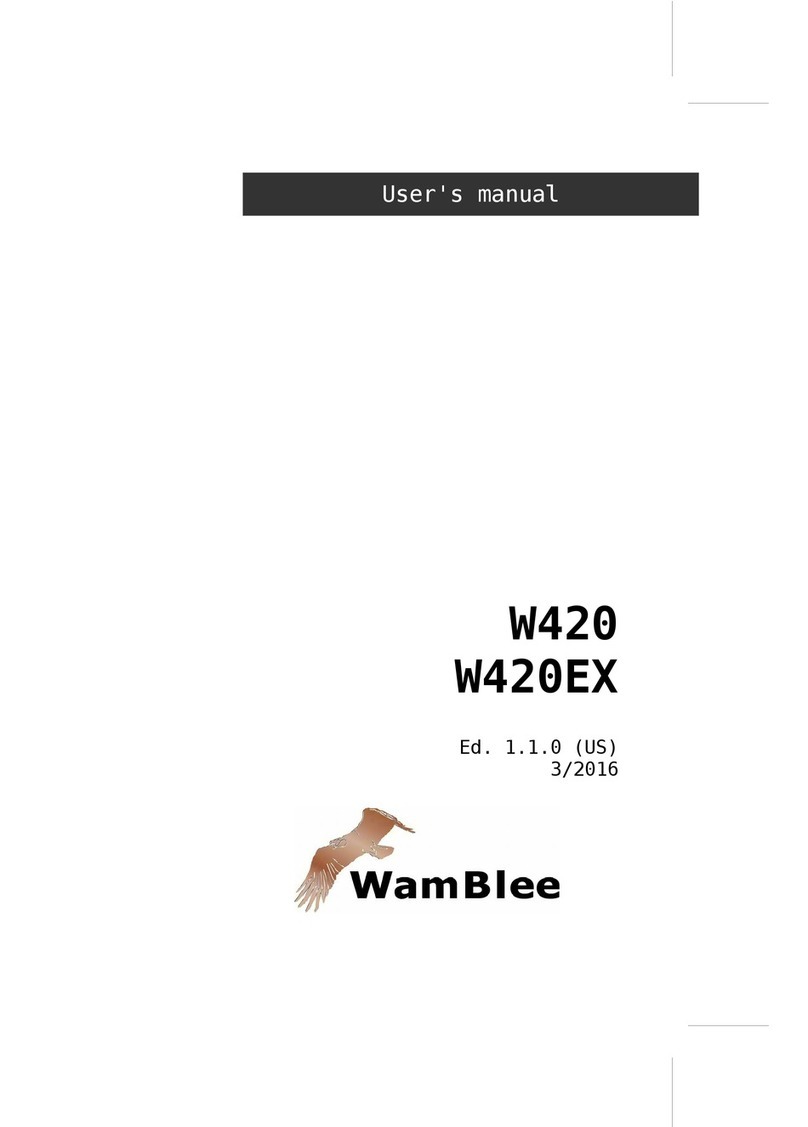Hama 40972 User manual

ENGLISH
FRANÇAIS
ESPAÑOL
DEUTSCH
ITALIANO
User's Manual
Manuel d'utilisation
Manual del Usuario
Benutzerhandbuch
Manuale utente
2.4 GHz Wireless
Audio/Video Sender


Product Layout/Figures des produits/Vista General del Producto
/Produktübersicht/Profilo del prodotto
Figures and Quick Guide/
/
Figures et guide rapide
Figuras y Guía Rápido/Abbildungen und Schnellanleitung
/Figure e guida rapida
Receiver/Récepteur/Receptor/Empfänger/Ricevitore
Transmitter/Transmetteur/Transmisor/Trasmittente
Fig. 1
Fig. 2
Receiver/Récepteur/Receptor
/Empfänger/Ricevitore
Transmitter/Transmetteur
/Transmisor/Trasmittente
i
1
2
567
4
3
3456

Setting up/Installation/Instalación/Einrichtung/Configurazione
1
Scart Cable for PAL System
/Câble péritel pour système PAL
/Cable tipo Scart para Sistema PAL
/Scart-Kabel für PAL-System
/Cavo scart per standard PAL
VIDEO
OUT
VIDEO AUDIO RF OUT
Transmitter
OUT
TV
OUT
Setting up the Transmitter/Configuration du transmetteur
/Instalación del Transmisor/Einrichten des Transmitters
/Installazione del trasmettitore
A/V Connection /Connexion A/V/Conexión de A/V
/A/V-Anschluss/Connessione A/V
RF Connection - for TV without A/V Input Jacks
/Conexión RF- pour équipements A/V sans fiches de sortie A/V de rechange
/Connexion RF- Pour les équipements A/V sans connecteur A/V de sortie
/RF-Anschluss für A/V-Gerät ohne zusätzliche A/V-Ausgabebuchsen
/Connessione RF per dispositivi A/V senza jack di uscita A/V aggiuntivi
1.1
Scart Cable for PAL System
/Câble péritel pour système PAL
/Cable tipo Scart para Sistema PAL
/Scart-Kabel für PAL-System
/Cavo scart per standard PAL
Fig. 3
Connect the Transmitter to an A/V Equipment
/Conecte el Transmisor a un Equipamiento de A/V
/Connecter le Transmetteur à un équipement Audio/Vidéo
/
/
Anschließen des Transmitters an ein A/V-Gerät
Connessione del trasmettitore a un dispositivo A/V
Transmitter
VHF/UHF ANT. IN
OUT
VIDEO AUDIO RF OUT
A/V Component
Fig. 4
ii

1.2 Power Supply/Alimentation/Alimentación/Stromversorgung
/Alimentazione
Fig. 5
Setting up the Receiver/Configurazione du récepteur
/Instalación el receptor/Einrichten des Empfängers
/Installazione del ricevitore
2
A/V Connection - for TV with A/V Input Jacks
/Connexion A/V pour les téléviseurs avec des prises d'entrée A/V
/Conexión A/V - para TV con enchufes hembra de entrada deA/V
/A/V-Anschluss für Fernseher mit A/V-Input-Buchsen
/Collegamento A/V per televisori provvistidi prese d'ingressoA/V
2.1
IN
TV
VIDEO AUDIO
IN
Scart Cable for PAL System
/Câble péritel pour système PAL
/Cable tipo Scart para Sistema PAL
/Scart-Kabel für PAL-System
/Cavo scart per standard PAL
Fig. 6
Connect the Receiver to an A/V Equipment
/Connexion du récepteur à un téléviseur
/Conecte el receptor a una TV
/Anschließen des Empfängers an einen Fernseher
/Collegamento del ricevitore ad un televisore
Receiver
iii
2
Transmitter
1
3

IN
TV
VHF/UHF
RF Modulator
RF Connection - for TV without A/V Input Jacks
/Connexion RF pour les téléviseurs sans prise d'entrée A/V
/Conexión RF - para TV sin enchufes hembra de entrada de A/V
/RF-Anschluss für Fernseher ohne A/V-Input-Buchsen
/Collegamento RF per televisori sprovvisti di prese d'ingresso A/V
Connection through an A/V Component
/Connexion par l'intermédiaired'un équipement A/V
/Conexión a travésde un componenteA/V
/Anschluss über eineA/V-Komponente
/Collegamento tramite uncomponente A/V
Scart Cable for PAL System/Câble péritel pour système PAL
/Cable tipo Scart para Sistema PAL/Scart-Kabel für PAL-System
/Cavo scart per standard PAL
A/V Component
Scart Cable for PAL System/Câble péritel pour système PAL
/Cable tipo Scart para Sistema PAL/Scart-Kabel für PAL-System
/Cavo scart per standard PAL
2.2 Power Supply/Alimentation/Alimentación/Stromversorgung
/Alimentazione
Fig. 7
Fig. 8
VIDEO AUDIO
IN RF OUT
CH 3/4
Receiver
Receiver
IN
TV
VHF/UHF
RF OUTRF OUT
VIDEOVIDEO
VIDEO AUDIO
IN RF OUT
2
1
3
Fig. 9
Receiver
iv

Using Remote Control/Utiliser la commande à distance
/Uso del mando a distancia/Verwenden der Fernbedienung
/Utilizzo del telecomando
Fig. 10
Fig. 12
Fig. 11
v
Transmitter
AV Source Component
TV
Receiver
Remote control
Align
AV Source Component
Transmitter
IR Eye
TV
Receiver
Remote control
AV Source Component
Transmitter
IR Eye
TV
Receiver
Remote control


What You Get
One Transmitter
One Receiver
One Infra-red (IR) eye
TwoA/V(Audio/Video) Cables (mini-RCAor mini-Scart)
TwoPower Adapters
This User's Manual
Note: The transmitterand receiver look very alike. You can find
"Transmitter" and"Receiver" on the top of the units. See Fig. 1.
Product Layout
Transmitter/Receiver (Fig. 2)
1. IR Antenna
2. Power Indicator/IR Window
3. Power AdapterPlug
4. ON/OFF Switch
5. A/V Jack
6. Channel Selection Switch (Select the channel by sliding the slide switch to the
channel number youwant. Note: Must select the same channel both on
transmitter and receiver)
7. IR Eye Plug
Setting up
Before you make the connection:
Set the channelswitches on theback of thetransmitter and receiverto the same
channel.
Depending on the type of TVyou own and the component A/V system (VCR,
DVD player,etc.), connection methods will be different. We recommend you
refer to the connected A/V component's user's manual for details, then make
connections according to the following steps.
Setting up the Transmitter
Connect the Transmitter to an A/V Component
A/V Connection
Connect the miniplug of theprovided A/V cables to theA/V jack on the rear
of the transmitter; connect the other end of the cable to the A/Vjacks (or
Scart connector) of the A/Vcomponent labeled LINE OUT. See Fig. 3.
1
1.1
ENGLISH
1

RF Connection- for A /V Component without Spare A/V
Output Jacks
If yourA/V componenthas only oneset ofA/V output jacks, and youwant to
use it with a nearby TV, connect coaxial cable from the single OUTport on
the A/V component to theVHF/UHF In porton your TV. In orderto also
view cable transmissionon thatT V, connect yourincoming cable T V source
to the single IN port of the A/V component. Please see Fig. 4.
Note 1: On an NTSCsystem, the connectoron theA/V equipmentis an
RCA jack. Connect the yellow plug to the jack labeled VIDEO,the red plug
to the jacklabeled AUDIO RIGHT and the whiteplug to thejack labeled
AUDIO LEFT.
Note 2: On a PA L system,connect the Scart connector labeled
TRANSMITTER to theScart connector labeledOUT onthe A/V equipment.
Note 3: If the A/Vequipment has only one output for audio (mono sound
only), connect the white plug to that single audio output jack.
Power Supply
1. Plug one end of the provided power adapter into a wall outlet and the
other end into the rear of the transmitter. See Fig. 5.
2. Turn onthe transmitter. TheLED on the front of the unit should light up.
Setting up the Receiver
Connect the Receiver to a TV
A/V Connection - for TV with A/V Input Jacks
Connect the mini-plug of the provided A/Vcables to the A/V jack on the
rear of the receiver; connect the other end of the cable to the A/V jacks (or
Scart connector) of the TV labeledLINE IN. See Fig. 6.
RF Connection - for TV without A/V Input Jacks
If there is no A/V input jacks on your TV, you will need to get an RF
modulator (available at your local electronic store) to make the connection
between TVand receiver. See Fig. 7.
Connection through an A/V Component
If anA/V component (VCR, DVD player, DBS receiver etc.) is connectedto
the TV already, you can just connect the receiver to the free LINE IN jacks
on the A/V component. See Fig. 8.
Note 1: On an NTSC system, the connector on the TV isan RCAjack.
Connect the yellowplug to thejack labeledVIDEO, the redplug to thejack
labeled AUDIO RIGHT and the whiteplug to thejack labeledAUDIO LEFT.
Note 2: On a PA L system,connect the Scartconnector labeled
TRANSMITTER to theScart connector labeledIN on theTV.
1.2
2
2.1
2

Note 3: If theTV has only one inputfor audio (monosound only), connect
the white plug to that single audio in jack.
Power Supply
1. Plug one end of the provided power adapter into a wall outlet and the
other end into the rear of the receiver. See Fig. 9.
2. Turn onthe receiver. TheLED on the front of the unit should light up.
Other Applications
Using Remote Control
The Wireless A/V sender gives you the ability to control A/Vcomponents from
another room using your existing remote control device. To use this function,
follow the steps below:
1. Place the transmitter on top of the A/V source component. Make sure that the
front of thetransmitter is alignedwith the frontof the sourcecomponent. Set
the IR antenna on the transmitter upright. See Fig. 10.
OR
Place the transmitter next/close to the A/Vsource component and plug the IR
eye into thejack located onthe rear ofthe transmitter.
Set the IR
antenna on thetransmitter upright.
2. Position the receiver so that your remote control signal can strike the IR window
on the frontof the receiver. Set theIR antenna onthe receiver upright.
3. To use your remote control, point it at the front of the receiver and operate it as
you normally would.
Connect the Transmitter to a Camcorder
The Wireless A/V Sender can be usedto send a picture from camcordersto any TV
without wires.
Connect one set of A/V cables to the A/V jack of the transmitter and to the output
jacks of thecamcorder, matchingthe plug colorswith the jackson the camcorder.
Connecting to a Stereo System
You can connect the Wireless A/V Sender to your stereo system, to enjoy sound
from your CDplayer, cassettedeck, or radio, on speakersin another room.
1. Connect the mini plug of one set of A/V cables to the A/V jack on the rear of the
transmitter; connect the other end of the cable to the two audio jacks (red and
white) of the stereo system, matching the plug colors with the jacks on the
transmitter. The yellow video plug is not used.
2. Connect the mini plug of one set of A/V cables to the A/V jack on the rear of the
receiver; connect the other end of the cable to the IN 1 orIN 2 jacks on your
stereo receiver or amplifier,matching the plug colors with the jacks on
component. The yellow video plug is not used.
Adhere the IR eye
directly to the IR window on the front of the source component (see Fig 11) OR
place the IR eye in front of the source component (see Fig. 12).
2.2
3

Transmitting from a Computer
The Wireless A/V Sender can send computer images and sounds (e.g. high-
resolution DVD) to a large TVscreen without running wires between the two. To
use this feature your computer must be provided with audio output (e.g. sound card)
and video output (e.g. VGA card with TV-output or external VGA-to-TVconverter).
1. Connect the mini-plugof a mini-RCAcable to therear of thetransmitter.
2. Connect the yellow (video) plug of the mini-RCAcable to the video jack on the
computer.
3. Connect a stereo mini “Y” adapter (available in any electronics store) into the
LINE OUTjack on the computer,and connect the red and white A/Vjacks to the
red and white A/V plugs of the mini-RCA cable which come from the
transmitter.
Receiving on a Computer
In conjunction witha video captureor TVtuner device, youcan turn yourcomputer
into a secondTV withoutrunning wires betweenthe computer andyour A/V
component.
1. Connect the mini-plugof a mini-RCAcable to therear of thereceiver.
2. Connect the yellow(video) plug ofthe mini-RCAcable to thevideo input jack
on the computer.
3. Connect a stereo mini “Y” adapter (available in any electronic store) into the
LINE IN jack on the computer,and connect the red and white A/V jacks to the
red and whiteA/Vplugs of themini-RCA cable which comefrom the receiver.
4

Troubleshooting
If you are not getting any signal at all
Check that thetransmitter and receiverare properly connectedto theA/V
components from whichyou want tosend/receive theA/V signal.
Make sure the transmitter and receiver are turned on.
Check power switcheson the remoteTV andvideo source (VCR,DVD player,
satellite receiver,etc.).
Make sure power plugs are pushed all the way in.
Check all cable connections.
Check the CHANNEL switch on both transmitter and receiver are set to thesame
number.
If you connect the receiverto a TV through an RF modulator, check that the TV is
tuned to the same channel as the TVChannel switch on the RF modulator (3 or 4).
If the signal is poor, or there is interference
Adjust the transmitter by rotating orientations until you get the best reception.
Change the channelon both transmitterand receiver andmake them thesame.
If there is a microwave oven in use in the path between the transmitter and
receiver, removethe microwave oven or turn it off.
Make sure thetransmitter and receiverare within rangeof each other(range of
approximately 300 feet; 100 meters in a clear line of sight).
Using a remote control, if you can not control the A/V source
component
Care and Maintenance
Keep all its parts and accessories out of the reach of young children.
Do not attempt to open the case. Non-expert handling of the device may damage it.
Keep dry. Precipitation, humidity, and liquids, contain minerals that will corrode electronic
circuits.
Do not use or store in dusty, dirty areas. Moving parts may be damaged.
Do not store in hot areas. High temperatures can shorten the life of electronic devices and warp
or melt certain plastics.
Do not store in very cold areas. When the A/V sender warms up (to its normal temperature),
moisture can form inside the case, which may damage electronic circuit boards.
Do not drop, knock, or shake it. Rough handling can break internal circuit boards.
Do not use harsh chemicals, cleaning solvents, or strong detergents when cleaning.
Operate this product using only the power supply included with it or provided as an accessory.
Do not overload electrical outlets or extension cords as this can result in fire or electric shock.
Try to replace the remotecontrol's batteries withnew ones.
Make sure to use the remote control of theA/V source component.
5

Specifications subject tochange without notice
Transmitter/Receiver
A/V Transmit Frequency2.4 GHz
Remote Control Freuency433.92 MHz
AV Signal Range 100 meters (300 feet) clear line of sight
Remote Control Signal Range 70 meters (200 feet) clear line of sight
AntennaBuilt-in omni-directional antenna
Channel 3 selectable channels
A/V mod/demod. methodFM
Audio Stereo audio input and output
Video Composite video input and output
Dimensions 13 (W) x 3.2 (H) x 10.5 (D) cm
(5.1 x 1.3 x 4.1 inches) each for transmitter/receiver
Weight 160g (5.6 ounces) each for transmitter/receiver
Power DC 9V, 300mA
Operating temperature 0 ~ 40 (32 ~ 104 )
FCC Statement
This equipment has been tested and found to comply with the limits for a Class B digital device, pursuant to Part 15 of the FCC Rules.
These limits are designed to provide reasonable protection against harmful interference in a residential installation. This equipment
generates, uses and can radiate radio frequency energy and, if not installed and used in accordance with the instructions, may cause
harmful interference to radio communications. However, there is no guarantee that interference will not occur in a particular installation.
If this equipment does cause harmful interference to radio or television reception, which can be determined by turning the equipment off
and on, the user is encouraged to try to correct the interference by one or more of the following measures:
Reorient or relocate the receiving antenna
Increase the separation between the equipment and receiver
Connect the equipment into an outlet on a circuit different from that to which the receiver is connected
Consult the dealer or an experienced radio/TV technician for help
FCC Label Compliance Statement:
This device complies with Part 15 of the FCC Rules. Operation is subject to the following two conditions: (1) this device may not cause
harmful interference, and (2) this device must accept any interference received, including interference that may cause undesired operation.
Note: The manufacturer is not responsible for any radio or TV interference caused by unauthorized modifications to this equipment.
Such modifications could void the user's authority to operate the equipment.
Specifications
6

Ce que vous avez
Un transmetteur
Un récepteur
Deux câblesA/V (Audio/Vidéo) (mini-RCAou mini-Scart)
Deux adaptateurs secteur
Un manuel de l'utilisateur
Remarque 1:
Voir Fig. 1.
Figures des produits
Transmetteur/Récepteur (Fig. 2)
1.
2. LED indicateur d'alimentation/
3. Prise d'adaptateur secteur
4. Commutateur Allumé/Eteint (ON/OFF)
5. Connecteur A/V
6. Bouton de sélection des canaux (Sélectionnez le canal en tournant le bouton
vers le numérodu canal quevous désirez. Remarque 1:Vo us devez choisir
le même canal sur le transmetteur le récepteur.)
7.
Installation
Avantde procéder à la connexion :
Configurez les commutateurs de canaux à l'arrière du transmetteur et du
récepteur pour qu'ilsutilisent le mêmecanal.
Selon le typede télévision quevous possédez etles composants dusystème
AV (magnétoscope,lecteur de DVD, etc.), les méthodes de connexion sont
différentes. Nousvous recommendons de vous référer au manuel d'utilisation
des composants AV connectés pour plus d'informations, puis de procéder aux
connexions en suivant les étapes décrites ci-dessous.
Un capteur infrarouge (IR)
L'émetteur et lerécepteur se ressemblentbeaucoup. Les
termes «Transmitter » (Emetteur) et « Receiver » (Récepteur)sont visibles
sur les appareils.
Antenne IR
Détecteur IR
Fiche du capteur infrarouge
FRANÇAIS
1

Configuration du transmetteur
Conecte el Transmisor a un Equipamiento de A/V
Connexion A/V
Connectez le mini connecteur des câbles A/Vqui sont fournis au connecteur
A/V situéà l'arrière dutransmetteur; connectez l'autreextrémité du câbleau
connecteur A/V (ou connecteur Scart) du composant A/Vnommé LINE OUT.
Voir Fig. 3.
Connexion RF- Pour équipements A/V sans fiches de
sortie A/V de rechange
Si vous possédez un équipement A/V qui n'a qu'un jeu de connecteur de
sortie A/V, et quevous désirez l'utiliseravec une télévisionà proximité,
connectez le câble coaxial au seul port OUTde l'équipement A/Vet au port
IN VHF/UHFde votre télévision.De manière à pouvoir voir les
transmission par câblesur cette télévision,connectez le câbleentrant de la
source de latélévision à l'uniqueport IN dumagnétoscope(VCR). Ve uillez
vous référer à la Fig. 4.
Remarque 1:Sur un systèmeNTSC, le connecteurdu composantA/V est
un connecteur RCA.Connectez la fichejaune au connecteur nommé VIDEO,
la fiche rougeau connecteur nomméAUDIO RIGHT et la fiche blancheau
connecteur nomméA UDIO LEFT.
Remarque 2:Pour un systèmePAL,connectez le connecteurScart nommé
TRANSMITTER au connecteurScart nommé OUTsur le composantA/V.
Remarque 3:Si le composantaudio/vidéo ne possèdequ'ne sortie audio
(son mono seulement),connectez la ficheblanche à cettesortie audio et
l'autre extrêmitè à la prise AUDIO GAUCHE dutransmetteur.
Alimentation
1. Branchez l'une des extrémités de l'adaptateur secteur fourni à la prise de
courant murale, et l'autre extrémité à l'arrière du transmetteur. Voir Fig.
5.
2. Allumez le transmetteur. Le LED sur le devant de l'unitlé doit alors
s'allumer.
Configurer le Récepteur
Connexion du récepteur à un téléviseur
Connexion A/V pour les téléviseurs avec des prises
d'entrée A/V
Connectez les mini fiches des câbles A/V fournis au connecteurA/V situé à
l'arrière du récepteur; connectez l'autre extrémité du câble auconnecteurs
A/V (ou connecteurs Scart) de la télévision nommé LINE IN. Voir Fig. 6.
1
11.
1.2
2
2.1
2

Connexion RF pour les téléviseurs sans prise d'entrée A/V
Si le téléviseur n'a pas de prise A/V, vous devez acheter un modulateur RF
(disponible dans les magasins d'électronique) pour établir la connexion
entre le téléviseur et le récepteur. Voir Fig. 7.
Connexion par l'intermédiaire d'un équipement A/V
Si un équipement A/V (magnétoscope, lecteur de DVD, récepteur RDS, etc.)
est déjà connectéau téléviseur,vous pouvez simplementconnecter le
récepteur aux prises d'entrée libres sur l'équipement A/V. Voir Fig. 8.
Remarque 1: Pour un système NTSC, le connecteur de la télévision est un
connecteur de typeRCA. Connectez lafiche jaune auconnecteur nommé
VIDEO, la fiche rouge au connecteur nommé AUDIO RIGHT et la fiche
blanche au connecteurnommé AUDIO LEFT.
Remarque 2: Pour un systèmePAL,connectez le connecteurScart nommé
TRANSMITTER au connecteur Scart nommé IN sur la télévision.
Remarque 3: Si votre téléevision ne possède qu'une entrée audio (son
mono seulement), connectezla fiche blancheà cette entréeaudio et à la
prise AUDIO GAUCHE durécepteur.
Alimentation
1. Branchez l'une desfiches de l'adaptateursecteur fourni dansla prise
murale et l'autre à l'arrière du récepteur. Voir Fig. 9.
2. Allumez le récepteurLe LED surle devant del'unité doit alorss'allumer.
Autres applications
1. Placez l'émetteur sur le composant source. Assurez-vous d'aligner l'avant de
l'émetteur avec l'avant du composant source. Relevez l'antenne IR sur l'émetteur.
Voir Fig. 10.
OU
Placez l'émetteur près du composantA/V source et branchez le capteur IR dans la
fiche au dos de l'émetteur.
Relevez l'antenne IR sur l'émetteur.
2. Placez le récepteur pour que le signal de votre commande à distance puisse
atteindre le détecteur IR sur l'avant du récepteur.Relevez l'antenne IR sur le
récepteur.
3. Pointez votre commande à distance vers l'avant du récepteur et opérez normalement.
Utiliser la commande à distance
L'émetteur A/V sans fil permet decontrôler les composantsA/V d'une autre salleen
utilisant votre commandeà distance. Pourutiliser cette fonction,suivez les étapes
ci-dessous :
Adhérez le capteur IR directement au détecteur IR à
l'avant du composant source (voir la fig. 11) OU placez le capteur IR devant le
composant source (voir la fig. 12).
2.2
3

Connexion du Transmetteur à un camescope
Le Wireless Audio/Video Sender peut être utilisé pour envoyer une image de
n'importe quel camescopevers une télévisionsans aucun fil.
Connectez un jeude câblesA/V auconnecteur A/V du Transmetteur et au
connecteur de sortiedu caméscope, enfaisant correspondre lescouleurs des fiches
des câbles avecles couleurs desconnecteurs du caméscope.
onnexion à un système stéréo
Vous pouvez connecter le Wireless Audio/Video Sender à votre système stéréo,
afin de pouvoirprofiter du sonde votre lecteurde CD, devotre lecteur decassette,
ou de votreradio sur deshaut-parleurs placés dansd'autres pièces.
1. Connectez la minifiche de l'undes jeux decâbles A /V auconnecteur A/V à
l'arrière du transmetteur; connectez l'autre extrémité du câble au deux
connecteurs audio (rouge et blanc) du système stéréo, en faisant correspondre
les couleurs des fiches du câble avec les connecteurs du émetteur. La fiche
vidéo jaune n'estpas utilisée.
2. Connectez la minifiche de l'undes jeux decâbles A/V au connecteur A/V à
l'arrière du récepteur; connecter l'autre extrémité du câble aux connecteurs
Entrée1 et Entrée2de votre récepteur ou de votreamplificateur stéréo, en
faisant correspondre les couleurs des fiches avec les couleurs des connecteurs
du composant. Lafiche vidéo jaunen'est pas utilisée
Transmission à partir d'un ordinateur
Le Wireless A/V Sender peut transmettre des images et du son d'un ordinateur (ex:
DVD haute-résolution) vers un écran de télévision large sans qu'aucune connexion
de câble ne soit effectuée entre les deux. Pour utiliser cette fonctionnalité, votre
ordinateur doit posséderune sortie audio(ex : unecarte son) etune sortie vidéo(ex :
carte VGAavec une sortie télévision ou un convertisseur externe VGA-vers-
Télévision).
1. Connectez la mini fiche du câble mini RCAà l'arrière du transmetteur.
2. Connectez la fiche jaune (vidéo) du câble mini-RCAau connecteur vidéo de
votre ordinateur.
3. Connectez un adaptateur stéréo mini " Y" (disponiblesdans tous les magasins
d'électro-ménager) au connecteurLINE OUTde votre ordinateur, puis
connectez les connecteurs A/V rouge et blanc au connecteur A/Vrouge et blanc
du câble mini-RCA qui vient du transmetteur.
C
4

Réception sur un ordinateur
En conjonction avec un périphérique de capture vidéo ou un tuneur de télévision,
vous pouvez fairede votre ordinateurune seconde télévisionsans pour autanttirer
de câbles entrel'ordinateur et lecomposant A/V.
1. Connectez la mini fiche du câble mini-RCA à l'arrière du récepteur.
2. Connectez la fichejaune (vidéo) ducâble mini-RCAau connecteur d'entrée
vidéo de votre ordinateur.
3. Connectez un adaptateurstéréo mini "Y"(disponible dans tousles magasin
d'électro-ménager) dans leconnecteur LINE INde votre ordinateur, puis
connectez les connecteursA/Vrouge et blancaux connecteursA/V rougeet
blanc du câble mini-RCAqui vient du récepteur.
Dépannage
Si vous ne recevez aucun signal du tout
Assurez-vous que letransmetteur et lerécepteur sont correctementconnectés
aux composants audio/vidéoavec lesquels vousvoulez envoyer etrecevoir les
signaux audio/ vidéo.
Assurez-vous que letransmetteur et lerécepteur sont allumés.
Vérifiez les commutateursd'alimentation sur latélévision et surla source vidéo
(magnétoscope, lecteur DVD, récepteur satellite, etc.).
Assurez-vous que toutesles prises sontbien branchées.
Vérifiez toutes les
connexions des câbles.
Vérifiez que lenuméro indiqué surle bouton duCANAL estle même sur le
transmetteur et le récepteur.
Si vous connectez le récepteur à une télévision avec un modulateur RF, assurez-
vous que le canal de la télévision est le même que celui du modulateur RF (3 ou 4).
Si le signal est faible ou si il y a des interférences
Changez le canal du transmetteur et du récepteur et choisissez le même pour les deux.
Assurez vous quele transmetteur etle récepteur sontà une distancecomprise
dans les limites de portée de chacun d'eux.
Ajustez le récepteuren le faisantpivoter jusqu'à ceque vous obteniez la
meilleure qualité de réception (approximativement 100 mètres de portée avec
ligne de vue dégagée).
Ajustez l'émetteur en le pivotant pour obtenir une meilleure réception.
Si vous ne pouvez pas régler le composant AV source avec une
commande à distance
Essayez de remplacerles piles de la commande à distance.
Assurez-vous d'utiliser lacommande à distancedu composantAV source.
5

Soin et entretien
Gardez tous lesaccessoires et pièceshors de laportée des enfants.
N'essayez pas d'ouvrir le boîtier. Une manipulation nonexpérimentée de l'appareilpeut
l'endommager.
Conservez les appareilsau sec. Lapluie, l'humidité, ou tout autre liquide,contiennent
des minéraux quipeuvent provoquer lacorrosion des circuitsélectroniques et leur
malfonctionnement.
N'utilisez pas etne placez pasles appareils dansdes endroits poussiéreuxou sales. Le
déplacement des différentes parties peutaussi causer leurmalfonctionnement.
Ne placez pasles appareils dansdes endroits chauds.Les hautes températurespeuvent
limiter la duréede vie descomposants électroniques, oufondre et fusionnercertains
plastiques.
Ne placez pasles appareils dansdes endroits froids.Lorsque le transmetteurA/Vchauffe
(et atteint sa température normale), desmoisissures peuvent seformer dans laboîte et
par la suiteendommager les cartesde circuits électroniques.
Ne faites pastomber, nefrappez pas etne secouez pasles appareils. Unerude
manipulation des appareilspeut endommager lescircuits internes.
N'utilisez pas deproduits chimiques, dedétergents oude solutions nettoyanteslorsque
vous nettoyez lesappareils.
Ne faites fonctionnerce produit qu'avecl'adaptateur d'alimentation inclusou fourni
comme accessoire.
Ne surchargezpas les prisesélectriques ou lescordons d'extension, carcela peut causer
des feux oudes électrocutions
6
Table of contents
Languages:
Other Hama Transmitter manuals
Popular Transmitter manuals by other brands
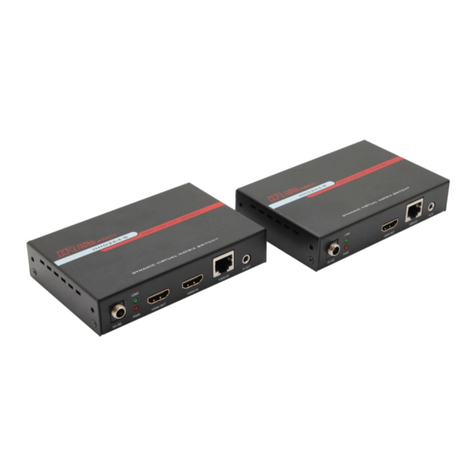
Hall Research Technologies
Hall Research Technologies HHD264 Quick installation guide

Vega
Vega VEGABAR 87 Quick setup guide
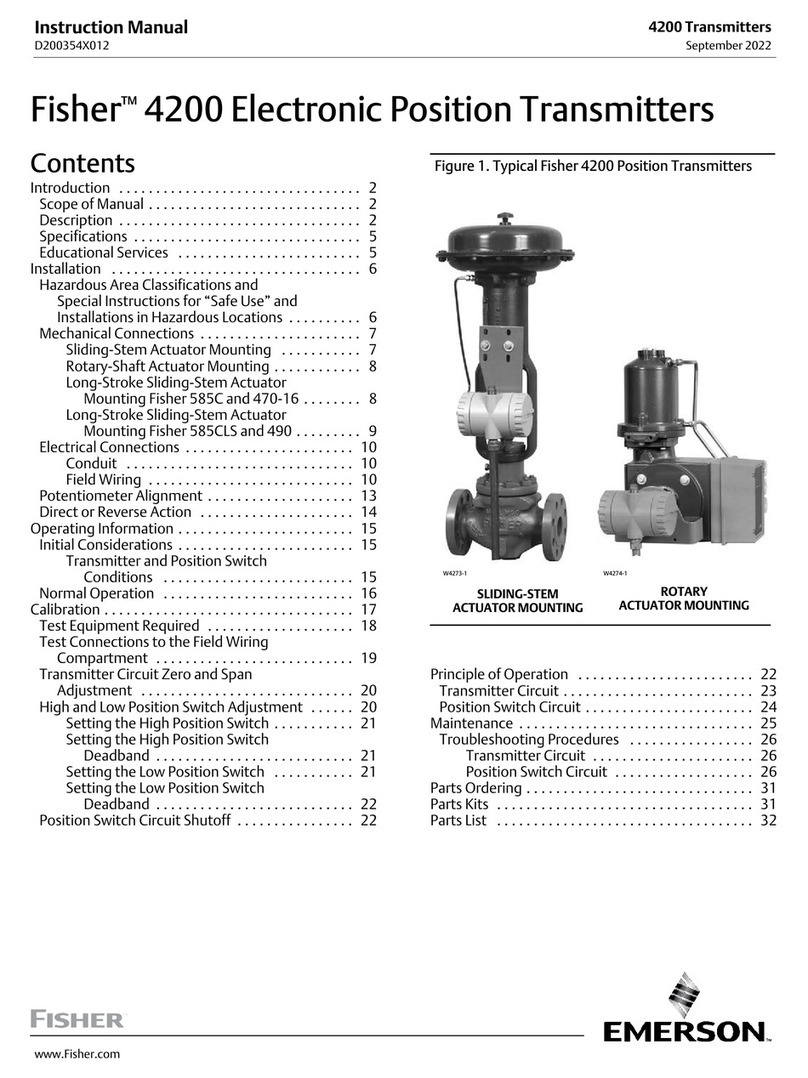
Emerson
Emerson Fisher 4211 instruction manual
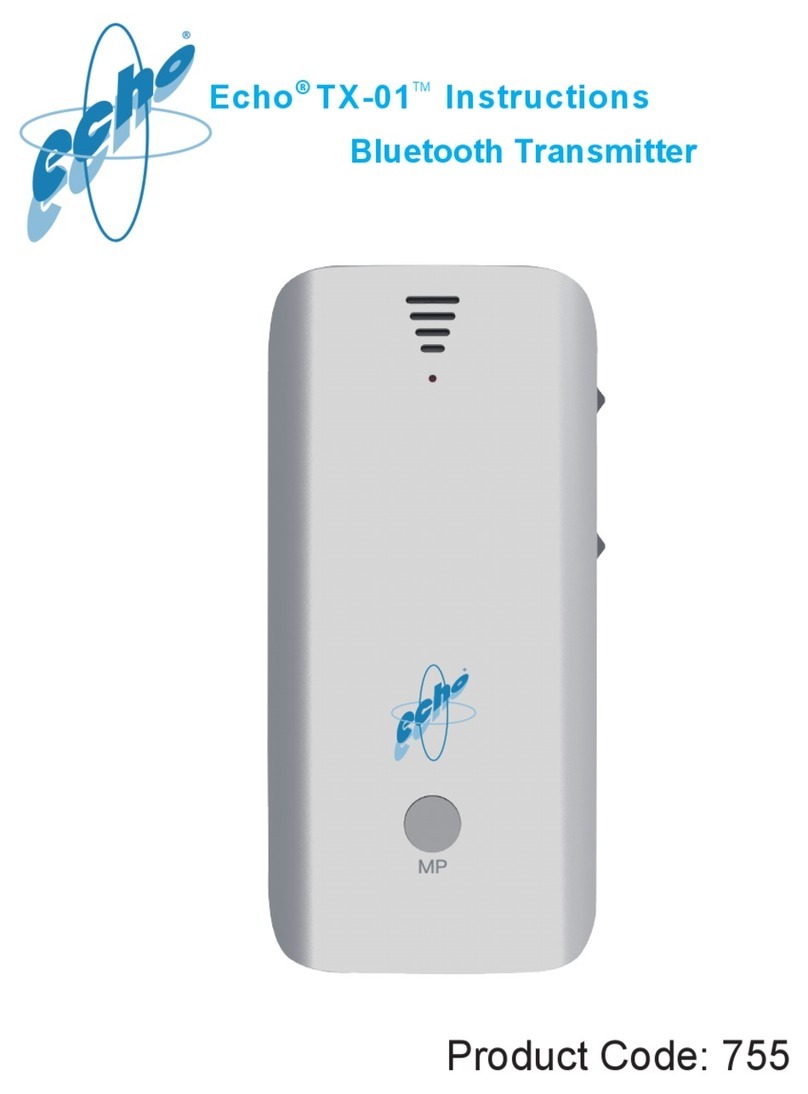
Echo
Echo TX-01 instructions

Nautel
Nautel NX50 Operation and maintenance manual
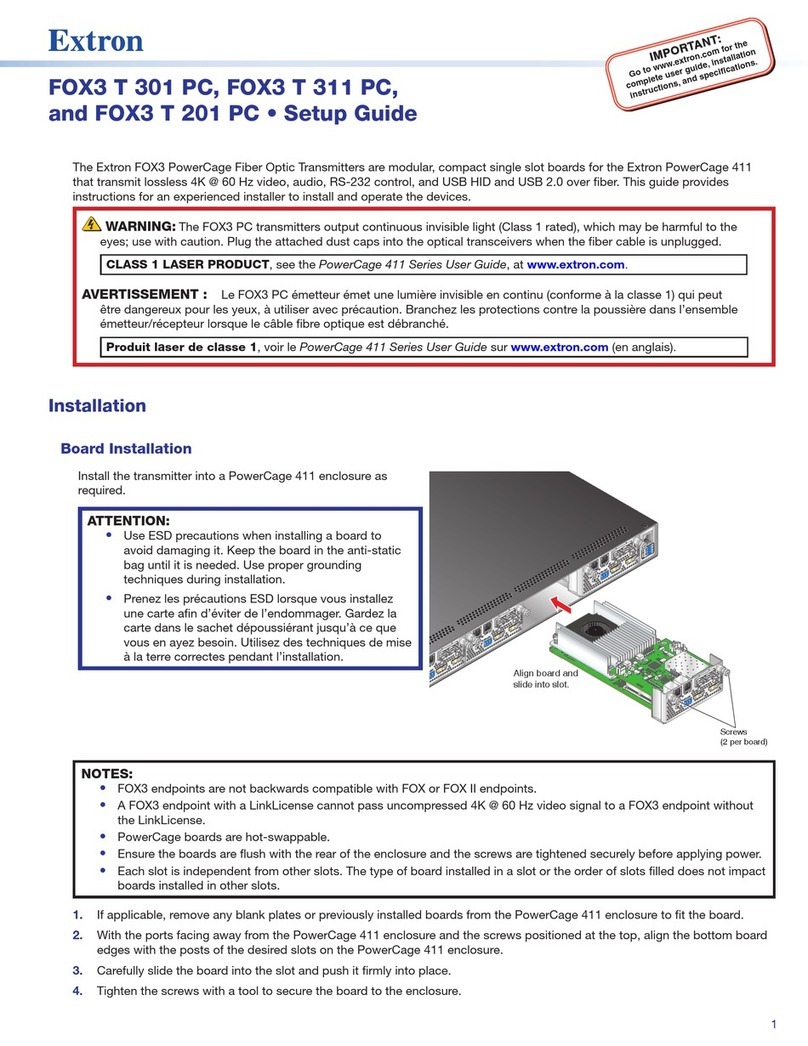
Extron electronics
Extron electronics FOX3 T 301 Setup guide


